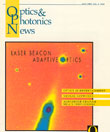
June 1993 Issue
Feature Articles
In 1880, Alexander Graham Bell and his assistant, Sumner Tainter, unveiled a dramatic advance in optical communication technology, which they called "the photophone." Without the benefit of lasers or modern detectors, the photophone could transmit a human voice hundreds of meters on a beam of light. The photophone was the world's first electro-optical system, and Bell and Tainter's experiments preceded wireless voice communication by radio by at least 19 years.
by Robert Q. FugateAlexander Graham Bell's Photophone
In 1880, Alexander Graham Bell and his assistant, Sumner Tainter, unveiled a dramatic advance in optical communication technology, which they called “the photophone.” Without the benefit of lasers or modern detectors, the photophone could transmit a human voice hundreds of meters on a beam of light. The photophone was the world's first electro-optical system, and Bell and Tainter's experiments preceded wireless voice communication by radio by at least 19 years.
by D. L. Hutt, K. J. Snell, and P. A. BelangerMerging Optics and Electronics In Neural Networks
Over the past few decades a class of massively parallel, high-speed computational models, generically referred to as neural networks, has been intensely studied. These models are, in some form, based upon the structure and function of the neurobiological systems found in animals. Much of the interest in this field is due to the fact that biological systems are able to solve problems, such as visual object recognition and verbal communications, that are currently very difficult or impossible to solve using standard computational models.
by Martin A. Brooke and Stephen P. DeWeerthEngineering Approximations Of Common Aero Optics Effects
Aerodynamically introduced optical aberrations occur in all types of moving, transmitting or receiving optical systems. While these distortions have always been present, the advances in the quality of the optics and image processing technologies are only now making the general topic of aero optics a concern to optical designers. In the immediate vicinity of the moving vehicle, the general cause of this type of optical distortion is a variation in the density of the surrounding media, as it is displaced by the vehicle. Depending on the nature of the motion of the optical platform, a host of different types of distortions can be introduced. These run the gamut from steady state effects that act as an optical element, to time variable losses that are treated as statistical processes.
by Leonard John Otten IIITales From An Oklahoma Shooting Range
Recently, a friend of mine in Oklahoma, Bruce Palmer, participated in a shooting match on a foggy day. The conventional wisdom among target shooters is that, to sight your rifle, you must use a fluorescent orange disk against a white background. This opinion is so strongly held that Bruce was severely ridiculed when, in defiance of accepted practice, he used a black disk. Yet he was the only shooter that day who could see his sighting target. To make this triumph of science over folklore even sweeter, Bruce used a black disk much smaller than the bright orange disks of his fellow shooters, who had to resort to the ridiculous measure of sighting their rifles by shooting blindly into the fog and listening for the sound of their bullets hitting targets.
by Craig F. BohrenBuilding Blocks For The Future
I am often asked for background material relating to standards, standards organizations, and policy about standards. Until recently, I have not been aware of a good reference addressing these questions. In March 1992, the Congressional Office of Technology Assessment published the results of a study on standards issues at the request of Congress. This report, Global Standards: Building Blocks for the Future, is the most comprehensive document I have seen about the history of standards writing, the effect of standards on the economy, and the changes in policy needed to keep the U.S. standards effort abreast of the changing world economic situation.
by Robert ParksStriving For The Ultimate Image
At seven a.m. on a cold winter Sunday in Toronto, a large truck and several cars pull up at a suburban swimming pool. Out of the truck comes all the paraphernalia of the movie business: lights, scaffolding, boxes full of camera accessories, a large white crate containing the one and only IMAX SOLIDO 3-D camera, and a large plywood box—its outsides gleaming with many coats of resin and sporting a bulbous acrylic dome as a window on one of its sides.
by Ken Baker and Hugh Murray

![Manual probe system with needles for test of semiconductor on silicon wafer. [A. Morozov / Getty]](https://opnmedia.blob.core.windows.net/$web/opn/media/images/articles/2025/1125/departments/202511-cover-web.jpg?ext=.jpg)
![Researcher Clara Saraceno in the lab. [Image by Carsten Behler Photography]](https://opnmedia.blob.core.windows.net/$web/opn/media/images/articles/2025/1025/departments/202510-cover-web.jpg?ext=.jpg)
